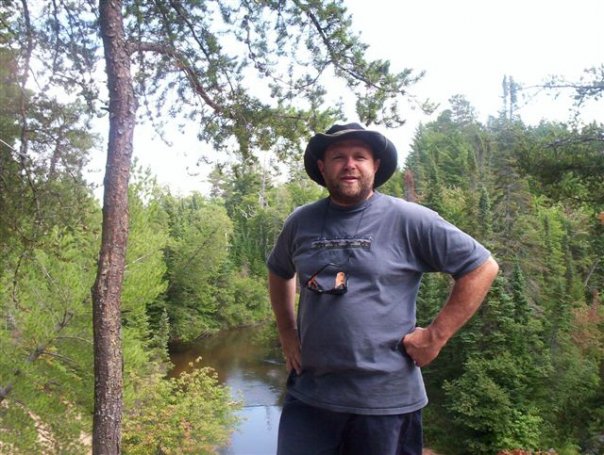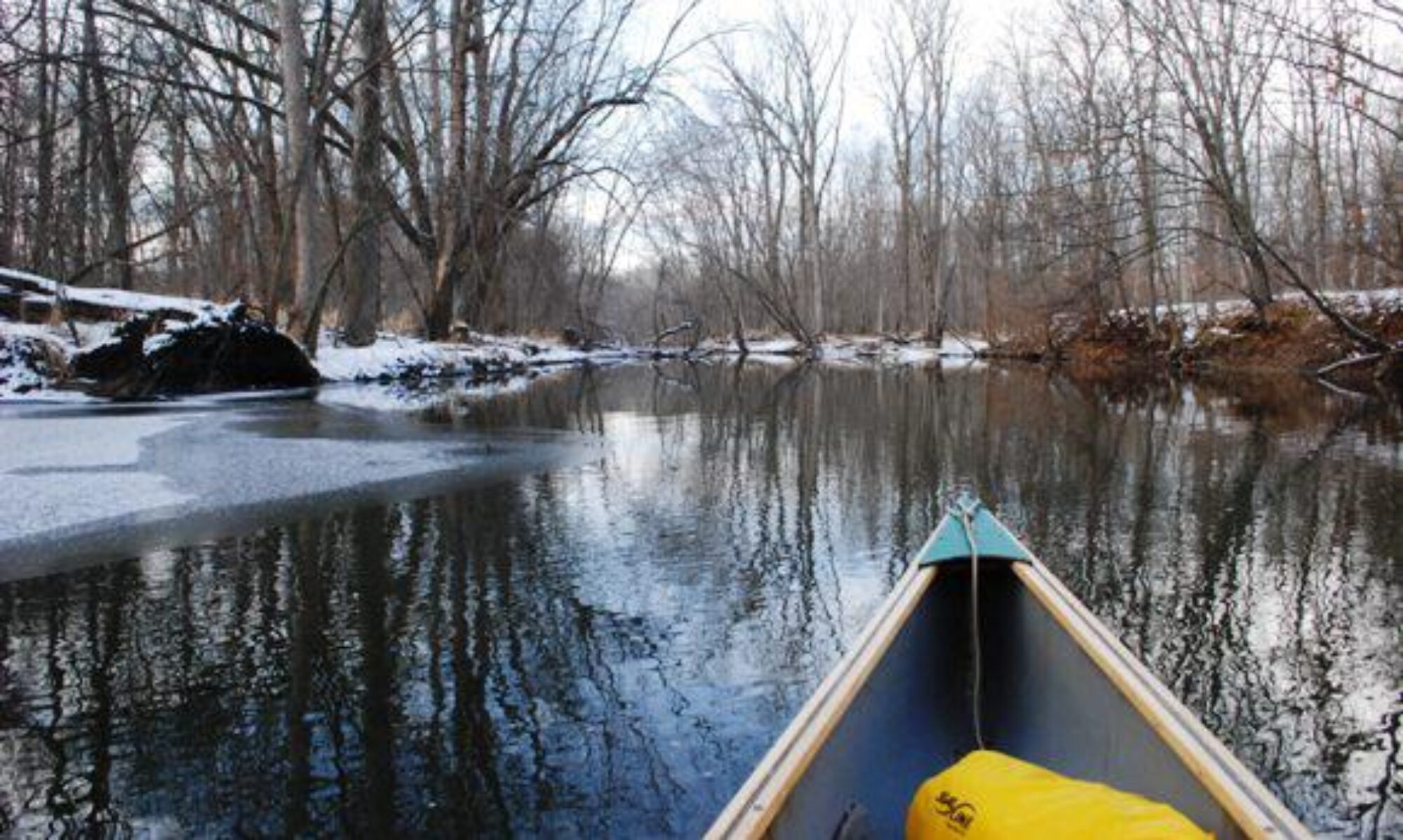The story below comes from 2007 and appeared in a slightly less edited version in a previous blog. In 2007, I spent a week paddling and fishing in Michigan’s Upper Peninsula. When living in Michigan, I was up in the UP almost every summer. This was before I switched to digital cameras and, sadly, have no photos. The photo below is of me paddling on the Two-Hearted River, the year before.

Reaching out into the dark waters with his paddle, drawing it toward the boat, Joe pulls the bow out into the river. For a moment, I hold the stern fast against the bank, allowing the current to catch the bow and spin us around and into the fast-flowing stream. It’s almost noon. And hot, Too hot for being this far north. At first, we don’t fish much and make good time, crossing under the highway bridge at Seney. A few minutes later we paddle under the rusty trestle of the Soo Lines. In 1919, when Hemingway visited this river, the line from the ferry at St Ignace on the northern side of the Mackinaw Straits ran all the way to Duluth, Minnesota. Today, the rusty rails of light iron have been severely amputated and stretch only from the main line at Trout Lake to Munising. There’s not much rail traffic left, mostly logs and shipments to and from a paper mill.
Continuing to paddle, we enter “The Spreads” about a mile below the tracks. Trees disappear and like an artery leaving the heart for the body, the river splits into smaller branches, cutting numerous deep channels cutting through tall grass. The channels are lined with shrubs, mostly tag elders, providing shade over the deep holes. We dig out the rods. At one of the bends, Joe, being in the front, pulls a small brook trout out of a hole. I continue to navigate the canoe, getting an occasional chance to fish, but with no luck. After a mile or so, the river comes back together, and the banks rise higher. We’re making good time. Tammarks, hemlocks and jack pines first appear. But as the stream draws us deeper into the northwoods, maples dominate the shoreline standing as sentries at guard. Others have fallen prey to the forces of water, creating log dams along the river providing us with both an obstacle to navigate and an opportunity for good fishing.
This is the country Hemingway describes in his short story, “The Big Two-hearted River.” High wooded ridges overlook a river filled with log dams under which deep holes are carved out. Trout hid in these holes. At first, instead of cursing the obstacles, we seize the opportunity. Approaching a jam, we beach the boat upstream in order not to spook the fish, jump out and fish the holes before portaging the boat over the logs and continuing downstream. This works well and by mid-afternoon, we’re approaching our limit of Brook Trout, a small but tasty native fish.
It’s still hot at six o’clock. Joe and I have caught our limit and, being good friends, offer to help the other two catch theirs. They’ve spent most of the day behind us, often forgoing fishing for swimming. However, we are also beginning to realize that these log dams are slowing our progress. They are now at most every bind. We begin to pass up some good holes to make up time.
At seven, we stop fishing. We’re still pulling over log dams. We haven’t reached the confluence with the East Branch. The deerflies are nasty, swarming around our heads. I zip the legs onto my pants and pull on a long sleeve shirt. A few minutes later, I pull the mosquito netting down over my face. It makes it difficult to see, especially obstacles right below the water line, but the netting provides relief from these deer flies that seem to have an immunity to DEET. Only my hands are exposed and for the next hour, I chum the river with dead deer flies, on one occasion killing four gnawing flies on one hand with a single slap. We’re making good time, having perfected the art of portaging over the log dam. But the East Branch remains elusive. We know we’ll have a good four or five mile paddling from the confluences.
In the summer, this far north and west in the time zone, the sun sets at 9:30 P.M. I begin to wonder at what point it will be prudent to pull over and make camp for the evening. I decide not to bring the subject up until after the sun is down, knowing that we’d still have a good half hour to gather firewood, clean fish for dinner, and to make as comfortable of a camp as possible. If we camp then, we’d only have six or seven hours of night, and we could get back on the river at first light. We finally pass the East Branch right around sunset and the water level rises and pace quickens. Yet, we still have a lot of river to cover before we reach Germfask, where we’ve dropped a vehicle. I pitch the idea of camping overnight on the bank, informing everyone that I do have some extra food and a lighter stashed away, but no one wants to quit. I’m concerned that in the dark it will be easy to tip a canoe and although I don’t think we have to worry about drowning, I worry about losing equipment, maybe even boats, in the dark.
A half mile past the East Branch, we join up with the Manistique. The river widens and there are fewer obstacles. We paddle furiously. The canoe guidebook suggested this should have be a five or six hour trip, with the author bragging that he made it in 4 ½. I wouldn’t buy a used car from the guy. As the light fades, we continue to paddle, but drop our speed to be extra careful. Right before dark, Joe and I split a energy bar. We haven’t eaten since lunch, nearly seven hours earlier, and I’m still not hungry, but need the energy. A few stars begin to appear. We keep close to one another, staying mostly in the middle of the channel. When my paddle hits the bottom of the river, I realize that it has changed from sand to rock. Occasionally we shoot across a rock garden with small waves splashing on the boat. I spot the pinchers of the constellation Scorpios just above the trees on the southern horizon.
At a little after eleven, we spot a fire up on the bank. It’s surrounded by a group of campers. We hail them and they’re surprised. Someone shines a flashlight at a spot where we can easily get the boats to shore. After pulling the boats on shore, we walk over to their campfire and ask if one of them would be willing to drive us to the car. “I’d love to, man,” one of them said, “but we’re all shit-faced, we’ve been drinking all day.” Looking around, it’s evident he’s telling the truth. Only a few of them are awake, several more are asleep, or more likely passed out, lying next to the fire. Since B’s vehicle is at the bridge, I suggest he and I hike back to get the car. “Maybe we’ll get a ride,” I suggest. We start walking up to the highway and through the town of Germfask. Only two cars pass us, but no one stops. Coming back, we clock it at 1.7 miles from the bridge to the campground. We quickly load the boats onto B’s trailer and drive back into Seney. It’s now midnight.
Not feeling up to cooking up fish, we head to the Seney Bar, the only place open in town. A few patrons sit at the bar, another couple are shooting a game of pool. We asked the bartender if we could get something to eat as we’d just come off the river. He confides that the cook left at 10 but offers to bake us some frozen pizzas. We ordered a couple and some beers. Hearing that we’d just gotten off the river, everyone in the joint begins to ask us about our trip while Joe hustles a few games of pool. One guy suggests he’d allow at least 12 hours for paddling the stretch we did. Someone else digs out a fishing guidebook, whose author suggested to allow 11 hours for just paddling and that if one wanted to fish, to make it a two-day trip. We agreed with that estimation and long to ring the neck of the author of the canoeing guidebook. Now that we’re safe, we laugh and enjoy another beer.
About 1 AM, we head back to the campground north of town. The others sleep in their vehicles. I quickly throw up my bivy tent, crawl in and crash. Five hours later, at 6 AM, I wake to the crash of close lightning. The wind is howling, breaking off limbs, and the clouds open, sending a deluge of rain. I debate making a run for my truck but decided to stay. I was warm and if a bolt hit the tree under which I was sleeping, I’d never know it. I watch the spectacular lightning show for a few moments, then fall back asleep thinking that it was good we didn’t spend the night on the river.

Thank you for sharing this post, I enjoyed it 🙂
All the best Jan
Well that was sure an exciting and fun trip.
Your story was great but it sort of made me sad. Up until a few years ago I would have loved such an adventure with the paddling down a river and camping. Throw in a visit to a bar and getting to know the locals would have been a blast.
Now, I’ve come to the point in my life the idea of roughing it doesn’t go beyond sleeping on a lumpy mattress and having to drive to a restaurant.
In fact, rather recently I’ve been invited on a few camping trips here in the Columbia, SC area and in the Upstate and have turned them all down. The idea of sleeping on the hard ground like I did in the army and while doing civilian camping just ain’t for me.
Hi!
I enjoyed your true story! Our daughter worked for at Isle Royals in the UP. She loved it! No cars! Flowers! Moose!! So, I can appreciate your adventure!
Great musings!
What an exciting trip…..I would have left the river before dark!! (If I was ever on it in the first place, which is doubtful!)
Very exciting ❤
That was exciting. You remind me why I’ve never ever considered a fun little jaunt to the UP Michigan rivers.
I had to smile at the part in which you offered to help the others catch their limit. Back in my hunting days, there were always those willing to help me fill mine.
I’ve been in enough scrapes like this one to always throw in an extra layer and some food… just in case. Nothing is worse than starting a day on the river after a night of rain and everything is wet and heavier.